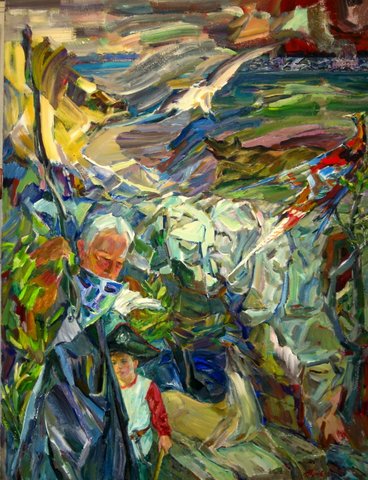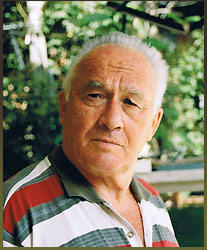| |
Born in 1932, Lithuania.
Childhood and adolescence spent in Siberia (deportation).
Studies:
Moscow "1905" Art School
1954-60 Surikoff Art Academy (Moscow).
1958-72 Exhibitions in USSR (two personal exhibitions in Moscow) as
well as outside its frontiers
Since 1972, lives and works in Jerusalem, Israel.
1975-76 Chairman of the Jerusalem artists and sculpturs asosiatiom
Regular personal exhibitions in Israel, North America, Germany, Switzerland,
France, Russia.
1972-83 Teaching art for in Haifa and Jerusalem Universities and Bezalel
Art Academy
1991-99 Manager of Sanur Artists' Village.
2001- Recipient of Jerusalem Ish- Shalom Fund "For special contribution
to the development of art".
2005 Elected as honorary member of the Russian Academy of Fine Arts
2009 Exhibited in State Tretyakov Gallery - Retrospective
2014 Exhibition "Unconscious reality", Moscow Museum of Modern Art (MMOMA)
53 works of Aharon April are in various museums in the world. |
| |
|
| |
 Unconscious reality Unconscious reality
Moscow Museum of Modern Art (MMOMA)
September-October 2014
Unconscious reality
Aaron April is an Israeli artist. He is well-known in Israel because his work is deeply rooted in national psyche and the art tradition of the Promised Land. However, one can also discern a certain influence of the Russian painting school in his oeuvre for the artist was educated in the USSR. It is the Soviet Union where the artist took the first steps while starting his career as a Soviet easel painter. In terms of his life and artistic career, April encountered twists and turns aplenty.

Circle of Time. 2013 |
Aaron April was born in 1932 in Lithuania, from whence his parents and he were sent into exile into Siberia in 1941. Siberia was the place where he grew up and got his first impressions of the bleak color emanating from the northern land. In 1948, he managed to enter the Moscow Art School in Memory of 1905 though his stint there was a brief one – he had to return to Siberia after the Soviet authorities had launched an anti-Semitic campaign otherwise filed under the catch-all term “The Doctors’ Plot.” April graduated from an art school in the city of Yakutsk. He pursued his interest in history by attending lectures at a local pedagogical institute. An opportunity to study in the capital arose after the death of Stalin. In 1960, April graduated from the Moscow State Academic Art Institute named after V.I. Surikov. For decades the artist had been taking part in many exhibitions including the international ones. “Behind the Seven Seas”, April’s first solo exhibition took place in 1971. The works
centered on the artist’s experience of traveling to India onboard the ship that was also calling on a number of ports on its way.
A new chapter of April’s life and work began in 1972 after he had moved to Israel and settled down in Jerusalem. April seems to have found a new direction for applying his artistic energy. He works hard, participates in exhibitions and supervises the activities of the artists’ community consisted of those who had emigrated from the Soviet Union. In 2001, April was awarded the Ish-Shalom Foundation Prize for the “Special Achievements in the Development of Art.”
In 2002, April’s exhibition titled by the artist himself “30 Years Later” was held in the Moscow Museum of Modern Art. The exhibition was a success. It seems to have been an attempt of the master to show the very revelation he experienced in the land of Israel. Watercolors depicting, for the most part, scenes from the Scriptures, were the centerpiece of the exhibition. A new exhibition of his work held in the halls of the venue on 10 Gogolevsky Blvd throws a new light on Aaron April as a watercolorist. This exhibition’s watercolors do not pertain only to spiritual subjects; there are also watercolor landscapes and allegoric compositions dealing with universal human issues. As far as the art of certain painters is concerned, it is noteworthy that the watercolor oftentimes plays second fiddle to oil painting. This does not apply to April. According to the artist, painting watercolors takes him a longer time than painting with oils. His approach toward the transfer of the luminescence of color is the key. By
and large, painting in oils lacks refinement to deliver the slightest nuances of color as to southern nature being reclaimed from the desert.
Meanwhile, spiritualism and April’s oeuvre go hand in glove. One should not forget that many of his works are speculative in nature. The artist virtually rejects to deal with figurativeness in some of his canvases, and for good reason. The spectator is supposed to guess the role of a certain stain in a composition that is filled with drama as a rule. This is not abstract art anyway. In fact, placing the work of Aaron April into the strict confines of some movement or trend is a difficult task. This is a very personal art stemming from the depth of the artist’s emotion. April’s interviews show that he is quite reluctant to give any clues as to symbolism or meaning of some of his motifs. The artist makes room for a mystery, a riddle. Perhaps this is his understanding of the work of a painter in general. Still, the history of Israel is the first to come into view of the spectator. It is essential that one should understand that the biblical images for April are not some “stories of days of old” but the very
fabric of today’s life, in which the living word of the Almighty, that of the kings and prophets has been woven.
The battle between good and evil is driven to the foreground by a whirl of colors. There are some intricate forms of either birds or insects with their hackles standing up. Those forms are laying claim to their place in a composition. It is not their frightening appearance – it is the mysterious depth of color that strikes one. The Russian artist Mikhail Vrubel appears to have arrived at the utmost threshold of this perception of evil after he had plunged his Demon into the glimmer of the precious range of dusky hues. It is against this frenzied kingdom that the light serene in its original wisdom is waging its war. The shining of this light comes from the rocks of the eternal Jerusalem, Aaron April’s hometown. There is no mistake in the above statement; Jerusalem is the artist’s motherland indeed notwithstanding the fact that the he was born thousands of miles away from the Holy City. The ancestral memory linking generations forms a strong bond for both Aaron April and the Hebrew people in general. The
artist found his spiritual and geographic refuge in that memory; he found his niche of a philosopher and a creator.
Vladimir Prokhorov
|
|

